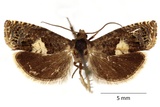Epiblema sticticana (Fabricius, 1794) Species
Last modified: Nov. 23, 2025, 6:21 p.m.
A widespread but rare species throughout Belgium.
Details
- Classification
- Family: Tortricidae > Subfamily: Olethreutinae > Tribus: Eucosmini > Genus: Epiblema > Species: Epiblema sticticana
- Vernacular names
- Variabele zadelmot (NL), Colt's-foot Bell, Colt's-foot Root-borer (EN), Huflattichwickler (DE)
- Synonyms
- Epiblema farfarae (Fletcher, 1938) and Epiblema brunnichiana sensu auct.
- First mention in Belgium
- De Crombrugghe G. 1906a. Catalogue raisonné des Microlépidoptères de Belgique. — Mémoires de la Société entomologique de Belgique XIII: 1–172; XIV: 1–155. On page 136.
- Status
-
Native
Distribution
Imago
Wingspan 15–20 mm. E. sticticana has a lighter olive-green coloration of the forewing than E. scutulana, but otherwise also very similar to E. cirsiana, so it is advisable to check the genitals.
Bionomics
The larva feeds when young in the roots, later on, and after hibernation, in the flower-stem. It pupates amongst the roots of the foodplant. The moths are active in afternoon sunshine until dusk and later come to light.
No pictures yet!
Flight periods
The adults have been observed from mid-May till late July, occasionally later.
Observed on
- Host plant (species):
- Tussilago farfara
The larva feeds on Tussilago farfara.
No pictures yet!
Habitat
It inhabits open grounds, wasteland, banks of streams and roadside verges.
No pictures yet!









